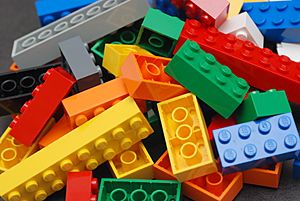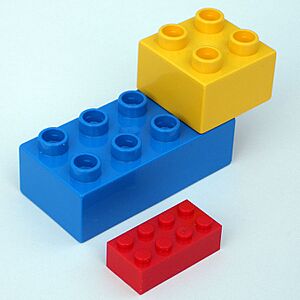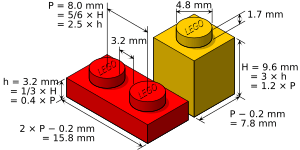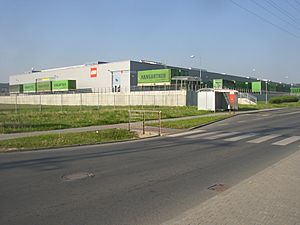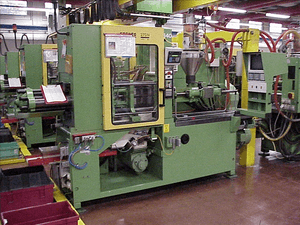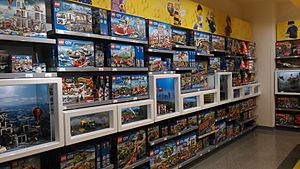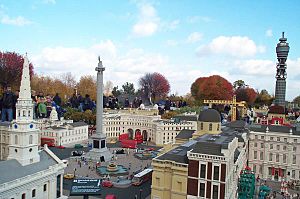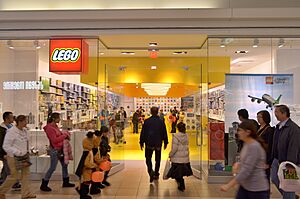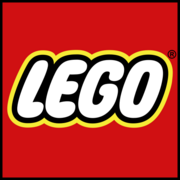
Logo used since 1998
|
|
| Type | Construction set |
|---|---|
| Inventor(s) | Ole Kirk Christiansen |
| Company | The Lego Group |
| Country | Denmark |
| Availability | 1949–present |
| Materials | Acrylonitrile butadiene styrene |
Lego is a super popular line of plastic building toys made by the Lego Group. This company is based in Billund, Denmark. Lego sets include colorful plastic bricks that snap together. They also come with gears, small figures called minifigures, and many other cool parts.
You can connect Lego pieces in tons of ways to build almost anything! Think vehicles, buildings, or even working robots. Once you build something, you can take it apart and use the pieces to create something totally new.
The Lego Group started making these interlocking toy bricks in 1949. Today, Lego bricks are made in places like Denmark, Hungary, Mexico, and China. The designs on the bricks and the packaging are done in the first three countries, plus the Czech Republic. Every year, about 36 billion Lego bricks are made. That's about 1,140 pieces every second! Lego is one of Europe's biggest companies and the largest toy maker in the world by sales. By July 2015, over 600 billion Lego parts had been produced.
Lego has a huge community of fans who love building amazing things. There are even building competitions! The Lego brand has also inspired many movies, video games, and ten Legoland amusement parks.
Contents
The Story of Lego
The Lego Group started in 1932. It was the workshop of Ole Kirk Christiansen (1891–1958), a carpenter from Billund, Denmark. He began by making wooden toys. In 1934, his company got the name "Lego." This name comes from the Danish phrase leg godt, which means "play well."
In 1947, Lego started making plastic toys. By 1949, the company was producing an early version of the interlocking bricks we know today. They called them "Automatic Binding Bricks." These bricks were inspired by the Kiddicraft Self-Locking Bricks. Those were invented by Hilary Page in 1939. Lego got a sample of the Kiddicraft bricks from a machine supplier. The first plastic bricks were made from cellulose acetate. They were an improvement on the wooden blocks people used to stack.
Lego's motto, "only the best is good enough," was created in 1936. Christiansen made this motto to remind his employees to always focus on quality. He believed in this strongly. By 1951, plastic toys made up half of the company's products. Some people thought plastic toys would never replace wooden ones. But Lego toys became very popular, partly because of Ole Kirk's high standards.
In 1954, Christiansen's son, Godtfred, became a leader at the Lego Group. He had an idea for a "toy system" after talking with a buyer. Godtfred saw that Lego bricks could be used for super creative play. But the bricks still had some issues. They didn't always lock together perfectly, and they weren't as flexible as they could be.
In 1958, the modern Lego brick design was created. Five years later, a stronger plastic called ABS replaced the old material. The patent for the modern Lego brick was filed in Denmark on January 28, 1958.
The Duplo product line came out in 1969. These blocks are twice as big as standard Lego bricks. They are made for younger children. In 1978, Lego made the first minifigures. These small figures are now a key part of most Lego sets.
In 1997, a big wave hit a cargo ship off the coast of Cornwall, England. More than five million Lego pieces were swept into the sea. These pieces have been washing up on beaches for decades, getting attention from news and social media.
In May 2011, the Space Shuttle Endeavour took 13 Lego kits to the International Space Station. Astronauts built models there to see how they would work in microgravity (zero gravity). This was part of the Lego Bricks in Space program. In May 2013, the largest Lego model ever built was shown in New York City. It was a life-size Star Wars X-wing fighter made of over 5 million bricks! Other record-breaking builds include a 34-meter (111-foot) tower and a 4-kilometer (2.5-mile) railway.
In February 2015, Lego was named the "world's most powerful brand." It even passed Ferrari!
Lego has always been a toy for kids. But now, many adults are also big fans. In 2020, Lego started making sets for ages 18+. These are often more expensive and harder to build. They are based on real-world or fictional things, like the Concorde airplane or Rivendell from The Lord of the Rings. These sets became popular during the COVID-19 pandemic. Many adults bought them to build during lockdowns. Movies like The Lego Movie and the TV show Lego Masters also made Lego popular with adults. By 2024, almost 15% of the sets sold in the U.S. were for adult builders.
In May 2025, Lego announced plans to move its London headquarters. It will move from Farringdon to 76 South Bank in 2027.
How Lego is Designed
Lego pieces are part of a universal system. This means that even though designs have changed over the years, all pieces still fit together. Lego bricks from 1958 can still connect with ones made today. Sets for young children also work with sets for teenagers. Did you know that six 2x4 Lego bricks can be combined in over 915 million ways?
Every Lego piece must be made very precisely. When two pieces connect, they need to fit tightly but also be easy to take apart. The machines that make Lego bricks are super accurate, with tiny differences of only 10 micrometres.
Most of the new Lego products are designed at the company's headquarters in Billund. About 120 designers work there. Lego also has smaller design offices in the UK, Spain, Germany, and Japan. These offices create products for their local markets. It takes about twelve months to develop a new product.
Designers first look at what's popular and what kids want. Some even visit toy shops or talk to children directly. Then, they design and develop the product. As of September 2008, design teams use special 3D modeling software to create drawings. They then make test models using a special machine. These models are shown to the team, and parents and children test them. Designs might change based on what people say. Virtual models of finished Lego products are also made. These are used for instructions, marketing, and packaging.
Lego Digital Designer was a special Lego software for computers. It let users create their own digital Lego designs. You could even order your custom designs as physical models, but this service ended in 2012. Now, Lego's website suggests using BrickLink Studio for digital building.
How Lego is Made
Since 1963, Lego pieces have been made from ABS plastic. As of September 2008, Lego engineers use special software to design the parts. This software helps them make sure the parts are perfect. Test molds are sometimes made before mass production starts.
The ABS plastic is heated to 232°C (450°F) until it becomes like dough. Then, it's injected into molds with strong forces. It takes about 15 seconds for the plastic to cool. The molds are made with tiny differences of up to twenty micrometres. This makes sure the bricks connect well. People check the finished bricks to make sure colors and thickness are correct. The Lego Group says that only about 18 bricks out of every million don't meet their high standards.
Lego factories recycle almost all of their plastic waste from making bricks. If the plastic can't be used for new Lego bricks, it's sold to other industries. In 2018, Lego set a goal to find a more eco-friendly plastic by 2030.
Lego bricks are made in several places around the world. Molding happens in Billund, Denmark; Nyíregyháza, Hungary; Monterrey, Mexico; and Jiaxing, China. Decorating and packaging are done in the first three countries and in Kladno in the Czech Republic. The Lego Group believes it has made 400 billion Lego blocks in five decades. About 36 billion bricks are made each year. Lego also makes a lot of small rubber tires. In 2006, it was said that Lego was the world's number-one tire manufacturer, making about 306 million small rubber tires a year. This was repeated in 2012.
In April 2023, Lego started building its first factory in the United States, near Richmond, Virginia. This new factory will be carbon-neutral and cost over $1 billion. It will have solar panels on the roof and ground. In April 2025, Lego opened its sixth factory worldwide in Vietnam. Lego says this is its most environmentally friendly factory yet.
In December 2012, a radio show asked how many Lego bricks, stacked up, it would take to break the bottom brick. Engineers found that a 2x2 Lego brick can hold about 4,240 newtons of force. Since a 2x2 brick weighs about 1.152 grams, it would take a stack of 375,000 bricks to break the bottom one. That stack would be about 3,591 meters (11,781 feet) tall!
Lego bricks can be put together and taken apart thousands of times before they start to wear out.
In 2018, Lego announced it would use plant-based plastic for parts like leaves, bushes, and trees. In 2020, Lego said it would stop using single-use plastic bags for packaging. Instead, it would use recyclable paper bags. In 2021, the company aimed to make bricks without using crude oil, by using recycled plastic bottles. However, in 2023, they changed this plan because it didn't reduce carbon emissions as much as hoped.
Lego Set Themes
Since the 1950s, the Lego Group has released thousands of sets with many different themes. These include space, pirates, trains, (European) castle, dinosaurs, and wild west. They also have original themes like Bionicle and Hero Factory. Some classic themes still made today are Lego City (sets showing city life, started in 1973) and Lego Technic (sets that copy complex machines, started in 1977).
Over the years, Lego has also made sets based on popular movies, cartoons, and video games. These include Batman, Indiana Jones, Pirates of the Caribbean, Harry Potter, Star Wars, Marvel, Minecraft and Wicked. Even though some of these licensed themes sold very well, Lego said in 2015 that they wanted to focus more on their own characters and classic themes. Sometimes, sets include small references to other themes, like a Bionicle mask in a Harry Potter set. Old, discontinued sets can become collectable and be worth a lot of money.
For the 2012 Summer Olympics in London, Lego released special Team GB Minifigures only in the United Kingdom. For the 2016 Summer Olympics and 2016 Summer Paralympics in Rio de Janeiro, Lego released a kit with the Olympic and Paralympic mascots Vinicius and Tom.
One of the largest Lego sets ever made was a minifigure-sized Star Wars Millennium Falcon. It was released in 2007 and had 5,195 pieces. Later, a 5,922-piece Taj Mahal set was bigger. But a redesigned Millennium Falcon (set 75192) took back the top spot in 2017 with 7,541 pieces. Since then, even bigger sets have come out: the Lego Art World Map (11,695 pieces), the Lego Titanic (9,090 pieces), and the Lego Architect Colosseum (9,036 pieces).
In 2022, Lego introduced its Eiffel Tower set (10307). It has 10,001 parts and is 149 cm (58.7 inches) tall. This makes it the tallest Lego set and tower, but it's second in piece count after the World Map.
Robotics Themes
Lego also created a line of robotics toys called Mindstorms in 1999. This line was updated and expanded until it was stopped in 2022. The idea for Mindstorms came from a special programmable brick made at the MIT Media Lab. The name came from a paper by Seymour Papert, a computer scientist who studied how people learn by building things. Lego helped fund his research.
The programmable Lego brick in these robotics sets was updated many times. The last version was called the 'EV3' brick, sold as Lego Mindstorms EV3. The set included sensors for touch, light, sound, and ultrasonic waves. Other sensors, like an RFID reader, were sold separately.
You could program the brick using official software on computers. In the first versions, you sent the program to the brick using an infrared signal. Later versions used Bluetooth or a USB cable. People also created other programming languages for Lego Mindstorms.
Several robotics competitions used Lego robotics sets. One of the first was Botball, a competition for middle and high school students in the U.S. Other Lego robotics competitions include FIRST LEGO League Discover (ages 4–6), FIRST LEGO League Explore (ages 6–9), and FIRST Lego League Challenge (ages 9–16). These programs give kids real-world engineering challenges. They use Lego robots to complete tasks. In the 2019–2020 season, there were over 38,000 FIRST LEGO League Challenge teams and over 21,000 FIRST LEGO League Explore teams worldwide. The international RoboCup Junior football competition also used a lot of Lego Mindstorms equipment.
The Mindstorms system has even been used for a special project called the Iko Creative Prosthetic System. This system creates prosthetic limbs for children. Kids can attach things like mechanical diggers or laser-firing spaceships to the end of their prosthetic limb. Iko was created by Carlos Arturo Torres, a designer from Colombia. It's a modular system that lets children customize their prosthetics easily, just like clicking Lego bricks together. This project worked with Lego's Future Lab and a Colombian foundation for physical rehabilitation. The prosthetic uses sensors that read muscle activity and control movement. A processing unit in the prosthetic's body has an engine that works with Lego Mindstorms. This lets the wearer build many different, programmable limbs.
Similar Building Blocks
The main patent for Lego bricks ended in 1978. Since then, other companies have made blocks that are similar in size and design. These blocks can also connect with Lego bricks.
In 2002, Lego sued the CoCo Toy Company in Beijing for copying their "Coko bricks." CoCo was told to stop making the products, apologize, and pay damages. Lego also sued the English company Best-Lock Construction Toys in Germany in 2004 and 2009. However, the German court did not give Lego trademark protection for the shape of its bricks in the later case. In 2005, Lego sued the Canadian company Ritvik Holdings Inc., which makes Mega Bloks. But the Supreme Court of Canada said Ritvik Holdings Inc. had the right to sell its product. In 2010, the European Court of Justice ruled that the eight-peg design of the original Lego brick is just a technical feature and cannot be a trademark.
In 2020 and 2021, Lego sent letters to small toy stores and popular YouTubers in Germany. These letters asked them to stop selling or promoting similar bricks. In 2021, a shipment of bricks from a company called Qman was stopped at German customs. This was because of concerns that they might be copying Lego's designs. The toy store that ordered them asked for donations to bring containers of these Lego-like bricks from China to Germany. They planned to donate them to children's homes. They received over €350,000 in just a few weeks.
Other Lego Services
Official Website
The Lego website first launched in 1996. It has grown a lot over the years. It's not just an online store and product catalog anymore. It also has moderated message boards that started in 2001. The site even has instruction booklets for all Lego sets made since 2002.
The Lego website also has a social media app called Lego Life. It's made for children under 13. The app is free and only has Lego-related content. It's a safe place for kids to share their Lego builds, photos, and videos. It also shows Lego ads, images, videos, and competitions. The app has many safety features to protect kids online. This includes protecting personal information and carefully checking all uploaded content and messages.
My Lego Network was a social networking site that had items, blueprints, ranks, and badges. Users earned badges for finishing tasks. They could also trade and earn trophies called masterpieces to move up in rank. The website had an inbox for sending pre-written messages. It also had "Networkers," which were automated characters who could send custom messages and sell masterpieces. The site closed in 2015.
Before My Lego Network, there were Lego Club Pages. They had a similar purpose but were less interactive.
Theme Parks
Merlin Entertainments runs ten Legoland amusement parks. The first one is in Billund, Denmark. Others are in Windsor, England; Günzburg, Germany; Carlsbad, California; Winter Haven, Florida; Iskandar Puteri, Malaysia; Dubai, United Arab Emirates; Nagoya, Japan; Goshen, New York; and a tenth opened in 2022 in Shanghai, China. On July 13, 2005, 70% of the Legoland parks were sold to the Blackstone Group for $460 million. Lego Group still owns the other 30%.
There are also eight Legoland Discovery Centres. Two are in Germany, four in the United States, one in Japan, and one in the United Kingdom. Two new Legoland Discovery Centres opened in 2013: one in Yonkers, New York, and one in Vaughan, Ontario, Canada. Another opened at American Dream Meadowlands in East Rutherford, New Jersey, in 2021.
Retail Stores

The very first Lego store opened in Sydney, Australia, in 1984. It was at the Birkenhead Point Outlet Centre. This store was not only the first dedicated Lego shop, but it also had cool displays. These included famous Australian landmarks like the Holden FJ car, Sydney Harbour Bridge, and the Sydney Opera House. It also had buildings from Amsterdam, dinosaurs, and an English Village. This store, called The LEGO Centre, closed in the early 1990s.
As of March 2024, Lego has 1031 retail shops around the world, called Lego Stores. The biggest Lego store in the world is in Leicester Square, London. U.S. stores include ones at the Downtown Disney shopping areas in Disneyland and Walt Disney World Resorts. There's also one in the Mall of America in Bloomington, Minnesota. When a new store opens, there's a special weekend event. A Master Model Builder, with help from volunteers, creates a giant Lego statue. This statue is then displayed at the new store for several weeks.
Business Consulting
Since about 2000, the Lego Group has offered "Lego Serious Play." This is a type of business consulting that helps people think creatively. Team members use Lego bricks to build models that show their ideas and experiences. People work through pretend situations using these 3D Lego creations. It's a serious way to play and explore new possibilities.
Other Lego Products
Video Games
Lego entered the video game market in 1997 by starting Lego Media International Limited. The game Lego Island was released that year. After that, Lego released games like Lego Creator and Lego Racers.
Later, Lego stopped publishing its own games. They partnered with Traveller's Tales. Together, they made popular games like Lego Star Wars, Lego Indiana Jones, Lego Batman, and Lego Marvel Super Heroes. In 2014, Lego made a game based on The Lego Movie because it was so popular.
Board Games
Lego Games launched in 2009. This was a series of Lego-themed board games. Players usually build the game board using Lego bricks. Then, they play with Lego-style game pieces. Some examples are "Minotaurus," where players roll dice to move characters in a brick-built maze. "Creationary" asks players to build something shown on a card. "Ramses Pyramid" involves collecting gems and climbing a customizable pyramid. Like many board games, these use dice. But in Lego Games, the dice are also made of Lego, with special Lego squares on the studs. The games range from simple to more complex.
Films and Television
The first official Lego film was Bionicle: Mask of Light, released straight to DVD in 2003. Several other computer-animated Bionicle and Hero Factory movies followed. Lego: The Adventures of Clutch Powers was a computer-animated film released on DVD in February 2010.
A computer-animated TV series called Lego Ninjago: Masters of Spinjitzu started in January 2011 for the Lego Ninjago brand. Another TV series, Legends of Chima, began in 2013 for the Legends of Chima brand. In December 2015, Nexo Knights debuted for the Lego Nexo Knights brand. An animated series called Lego Elves was released in 2015, and Lego Elves: Secrets of Elvendale in 2017 for the Lego Elves brand. In 2016, Lego Bionicle: The Journey To One was released for the Bionicle franchise, and Lego Friends: The Power of Friendship for the Lego Friends brand. In June 2019, Lego City Adventures was released for the Lego City brand. In 2021, Lego Monkie Kid was released to support the Lego brand of the same name.
The Lego Movie, a feature film based on Lego toys, was released by Warner Bros. in February 2014. It had famous actors like Chris Pratt, Elizabeth Banks, Will Arnett, and Morgan Freeman doing the voices. A contest was held for people to design vehicles to be used in the movie. After The Lego Movie came out, some toy stores had trouble getting enough Lego products. They said their Lego orders were canceled without warning, which made them stock similar toys from other companies.
A spin-off of The Lego Movie, called The Lego Batman Movie, was released in the US in February 2017. A sequel to The Lego Batman Movie was planned but later canceled.
In June 2013, it was reported that Warner Bros. was making a movie based on Lego Ninjago. The Hageman Brothers were set to write it, and Dan Lin and Roy Lee were producers. The film, The Lego Ninjago Movie, was released in September 2017.
In February 2019, The Lego Movie 2: The Second Part was released. This was a direct sequel to the first movie, with Chris Pratt in the main role.
On January 27, 2024, a new film called Piece by Piece was announced. It was released on October 11, 2024. It's a movie about the life of singer Pharrell Williams.
As of August 2025, Universal and the Lego Group are working on an animated Lego film. It's currently called Inner Child and is based on an idea by James Morosini.
Books and Magazines
Lego has a deal with the British publisher Dorling Kindersley (DK). They have made many illustrated books about different parts of the Lego toy. The first was The Ultimate Lego Book, published in 1999. In 2009, DK also made The LEGO Book. It came with a smaller book called Standing Small: A celebration of 30 years of the LEGO minifigure, which focused on the minifigure. A new version of The LEGO Book was published in 2012. DK also published books on Lego Star Wars and Lego sticker books in 2009.
Books about the Bionicle story were written by Greg Farshtey. They are still published in Europe by AMEET. Bionicle comics, also by Farshtey, were collected into graphic novels. This series ended in 2009 after nine years.
There was also the Lego Club and Brickmaster magazine, but Brickmaster stopped in 2011. The Lego Life Magazine was released in 2017 and replaced the Lego Club Magazine.
Clothing
Kabooki, a Danish company started in 1993, makes children's clothes called "Lego Wear." They have a license from the Lego Group. In 2020, Lego announced partnerships with Adidas and Levi's. In 2021, Lego announced more partnerships with Justhype and Adidas to make clothes inspired by the Lego Ninjago theme. In May 2021, Lego announced collaborations with Adidas to make products inspired by the Lego Vidiyo theme.
See also
 In Spanish: Lego (juguete) para niños
In Spanish: Lego (juguete) para niños




